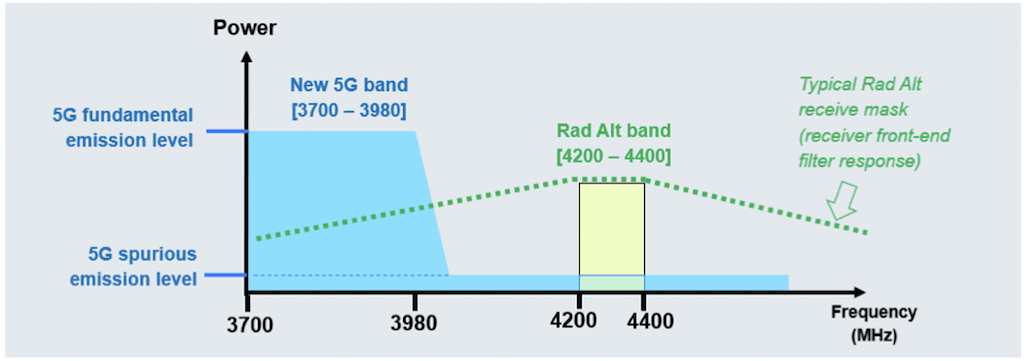Opinion: New 5G Frequencies Could Jam Critical Flight Instruments

In “The 5G Threat to Radio Altimeter Use” (column, Jan. 3),the author fails to understand how embedded radio altimeter signals have become in modern jet aircraft, or he simply makes light of the implications. This is not just about altitude reporting.
The C-band frequency spectrum recently auctioned by the Federal Communications Commission (FCC) is extremely close to radio altimeter operating frequencies.
The Radio Technical Committee for Aeronautics (RTCA), a technical guidance and advisory body to the FAA, fully analyzed how transmitting these new wireless frequencies from 5G base stations would affect radio altimeters. “The results [of] this report reveal a major risk that 5G telecommunications systems in the 3.7–3.98 GHz band will cause harmful interference to radar altimeters on all types of civil aircraft…including the possibility of catastrophic failures leading to multiple fatalities, in the absence of appropriate mitigations” it concluded in a report to the FCC.

Many critical aircraft systems are affected by radio altimeter inputs, such as flight control modes, auto-throttles, autopilot/autoland, air data systems, thrust revers, flight control law systems, electronic ground proximity warning systems (EGPWS), traffic alert and collision avoidance systems (TCAS), windshear warning and escape systems, flight directors, speed brakes/spoilers, tail strike protection, aural callouts, master caution and warning inhibits and more. This is not just a threat to low-visibility approaches.
The Congressional Research Service explains that 5G service in the U.S. targets low-band (e.g., 600 Mz), mid-band (e.g., 3.7-4.2 GHz) and high-band (e.g., 28 GHz, 24 GHz, 47 GHz) spectrums. High-band promised “unprecedented speeds,” but problems include short range and interference, high infrastructure costs (more antennas) and costly power consumption. In China, former national finance minister Lou Jiwei warned that increased electricity costs to fuel 5G necessitated government assistance.
In the U.S., telecom companies pursued high-band 5G service, but engineers realized this would require 4G/5G small cell poles every 250 to 750 ft. in residential neighborhoods, resulting in aesthetic blight and public resistance.
Also, the rollout of 5G did not live up to the initial hype. Tech publications say 5G phones achieve slower speeds than 4G phones in most cities and “appear essentially worthless,” which explains why two telecom companies are now pursuing C-band spectrum with such vigor.
But spectrum resources are limited. Consider the Frequency Allocation Chart below. The layers of frequency spectrum and congestion reveal a need for delicate balance, and it is now apparent that regulators captured by telecom lobbyists did not fully consider the safety ramifications of auctioning off a frequency band immediately adjacent to radio altimeters.
Electromagnetic interference (EMI) is a pesky problem.
The strategy of telecom giants, their lobbyists and to an extent the FCC are captured by the film “Don’t Look Up.” The telecom industry has adopted the strategy of the tobacco industry before it—to inject disingenuous public distractions, offer partial or misleading statements and make light of the serious concerns of others.
The gaslighting prize goes to FCC Commissioner Brendan Carr. In a letter to Transportation Secretary Pete Buttigieg on Jan. 1, 2022, posted on social media, Carr tries to distract public attention away from the most important aspect this spectrum issue, “the safety and operational integrity of the U.S. aviation system,” as made clear by Air Line Pilots Association President Captain Joe DePete. Carr’s letter makes light of a very serious aviation safety concern and is “disingenuous, misleading and displays a glaring disregard for the potential safety measures needed to protect the flying public,” asserts Rep. Peter DeFazio (D-Ore.), chair of the House Committee on Transportation and Infrastructure.
Frequency spectrum to telecom companies is like water to the West: They need spectrum to increase profits. With C-band, the FCC allowed a spectrum grab with only 220 MHz of separation from the Aeronautical Radio Navigation band, which falls short of protecting radio altimeters from interference, according to the RTCA. Spurious emissions further increase the risk to aviation safety.
As to power, radio altimeter transmitters have very low power output, only 40 milliwatts to 5 watts. That’s about the equivalent of powering a holiday light bulb. These low-powered mini-radars look straight down to report the height above ground to pilots and critical aircraft systems. Conversely, cell towers emit high power to maximize distance and saturate area with wireless coverage. Accordingly, the comparatively high-power pulsed C-Band transmissions present a substantial interference risk to radio altimeter accuracy and reliability. It is important to note that in other countries that allow 5G mid-band spectrum, operations are farther away from the radio altimeter frequency band, they operate at significantly lower power levels, they incorporate exclusion zones that limit or prevent 5G mid-band signals near runways, and/or they limit the directional tilt of certain 5G antennas.
Whether caused by mechanical failure or radio frequency interference, a broken radar altimeter or erroneous readings can be unforgiving and cause or contribute to a deadly crash.





Comments
That is a horrible mismatch to appoint attorneys to the FCC.
Attorneys should not be making decisions about technical information.
I have to ask the question: with all due respect, what does an attorney know of technical data? At Law Universities the curriculum does not include technical information, they study to be attorneys.
Until some in the Senate and/or Congress wakes up and will put and end to this madness we will have these type of problems, hopefully no aircraft accident will be caused by the 5G transmission.
That is a horrible mismatch to appoint attorneys to the FCC.
Attorneys should not be making decisions about technical information.
I have to ask the question: with all due respect, what does an attorney know of technical data? At Law Universities the curriculum does not include technical information, they study to be attorneys.
Until some in the Senate and/or Congress wakes up and will put and end to this madness we will have these type of problems, hopefully no aircraft accident will be caused by the 5G transmission.
No worries with real inflation at 50%, no one will be able to afford a 5G phone or an airplane with a radar altimeter!